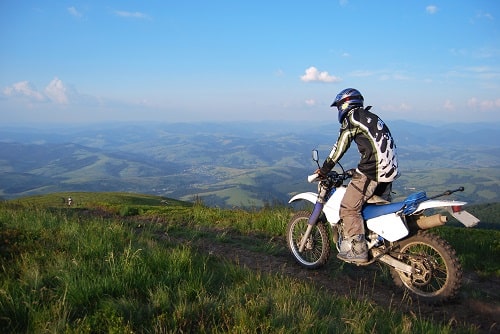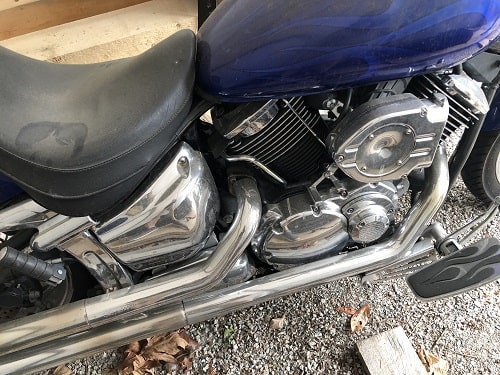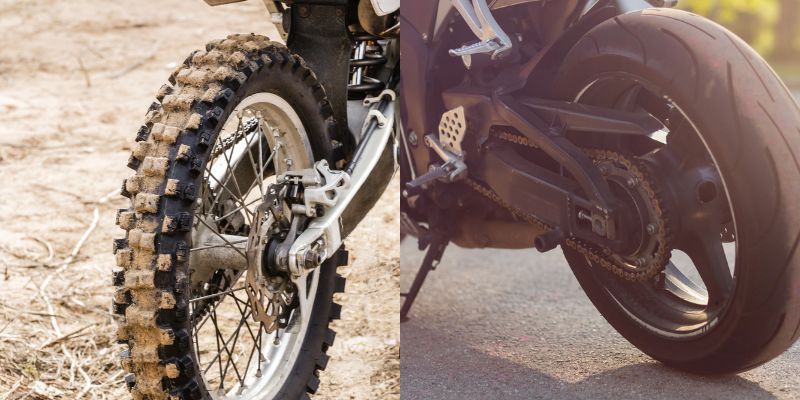Two wheels, two tires, handlebars, and a motor. Dirt bikes and street motorcycles may look like similar machines, but they’re actually very different and serve different purposes.
If you’re trying to decide between the two, read on to learn how they compare in design, safety, and accessibility.
Motorcycles vs Dirt Bikes: Different Features
Frame

Engineers design dirt bike frames with maneuverability and jumps in mind. As a result, their frames have more lightweight plastics as opposed to metal. Motorcycles utilize more aluminum and steel, though, so that they’re more stable and tougher in case of an accident.
Size and Weight

Because dirt bikes have more plastic in their frames, they weigh much less than street-ready motorcycles. Plus, they’re usually much smaller anyway to give them better agility.
While your average dirt bike has a curb weight of around 200 pounds (92 kg), most motorcycles weigh closer to 600 pounds (275 kg), with some large touring motorcycles weighing over 1,000 pounds (450 kg).
Tires

Dirt bike tires have a lot of tread and studs for extra traction on unpaved terrain. Moreover, they’re narrow to allow for better maneuverability.
Motorcycle tires, on the other hand, are wider and have less tread. This is better suited to paved roads while giving the motorcycle balance and stability.
Suspension
Dirt bikes are capable of absorbing big bumps and even impacts with the ground after being airborne. Their suspensions are much more advanced than those on motorcycles and include hydraulics as well as spring shocks. Motorcycles occasionally have hydraulic shocks too, but they’re normally more limited.
Brakes
Motorcycles require more powerful braking systems than dirt bikes because they move faster and have more momentum since they’re heavier. Plus, braking works better in general on a motorcycle since pavement provides more traction.
Dirt bike brake systems tend to be less powerful with smaller rotors. In fact, since dirt bikes don’t get much traction on off-road terrain, many older models didn’t even include a front brake.
Steering
Road motorcycles are not designed to take tight corners and turns. As a result, they have short handlebars. Dirt bikes, on the other hand, have wide handlebars to give you more leverage when cornering.
Gas Tank
Motorcycles generally have much larger fuel tanks than dirt bikes because they’re made to ride longer distances. This is another reason motorcycles are larger and heavier.
Seat Position
When you’re riding a dirt bike, you have to change your position constantly to maintain balance while jumping and taking tight curves and slaloms. To facilitate this, manufacturers put dirt bike seats farther forward.
However, on motorcycles, the seat is usually farther back. This is more comfortable on long rides and also gives you a bit more control of the larger machine.
Motorcycles vs Dirt Bikes: Which Is More Expensive?
There are fewer dirt bike models with a smaller range of options, features, and sizes. Consequently, you can find large street motorcycles costing more than $50,000 while dirt bikes rarely break $10,000.
On the other end, though, you can find basic small dirt bikes and motorcycles for around the same price, sometimes as low as $1,000.
That said, because dirt bikes must have more specific features like advanced suspensions and steering, they can often be slightly more expensive than a street motorcycle with the equivalent engine.
Motorcycles vs Dirt Bikes: Which Is Safer?
It may be a bit counterintuitive, but all else being equal, dirt bikes are actually safer than street motorcycles.
It’s pretty common to crash or wipe out on a dirt bike, but you’re moving at low speeds, and there aren’t hundreds of big cars and trucks around you also moving at high speeds.
In other words, while you might be more likely to get scraped up and bruised on a dirt bike, you’re more likely to end up in the hospital on a motorcycle.
However, there are a lot of factors involved. If you’re an experienced rider taking your cruiser at moderate speed on a straight, unpopulated country road, you’re probably safer than a newbie dirt bike rider who’s taking on a trail beyond their skill level.
For both motorcycles and dirt bikes, the most important factors to your safety are:
- Wearing your safety equipment. Most importantly, a helmet, but a jacket, armor, and appropriate footwear are essential as well.
- Knowing your skill level. Whether it’s the interstate or a difficult mountain slope, don’t take on the hard riding till you’re ready.
Motorcycles vs Dirt Bikes: Which Is Easier to Ride?
Learning the basics is easier on a street motorcycle than a dirt bike because you have more traction, and it takes less effort to maintain your balance.
Nevertheless, since you inevitably ride motorcycles at higher speeds and in more complex traffic situations, actually being road ready on a motorcycle takes more practice and time than being trail ready on a dirt bike.
Motorcycles vs Dirt Bikes: Which Should You Get?
Well, which do you want? If you’re looking for the adrenaline rush and skill-building of off-road riding, then you definitely need a dirt bike. If you want to go fast or travel long distances on paved roads, then you need a street motorcycle.
For commuting, you should probably get a motorcycle as well. You can ride a dirt bike on public roads if you get them registered and tagged and follow engine displacement requirements.
In this case, you may think you’re getting the best of both worlds, but you’ll inevitably find that your dirt bike isn’t especially comfortable or equipped for riding in traffic.
At the end of the day, dirt bikes are for riding off-road while street motorcycles are for riding on road. You need the appropriate machine for whichever you’re planning to do.